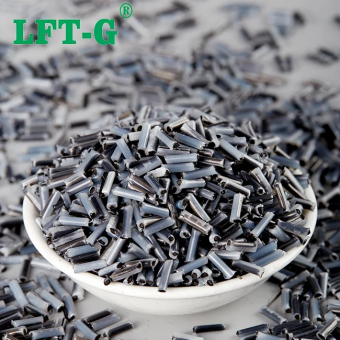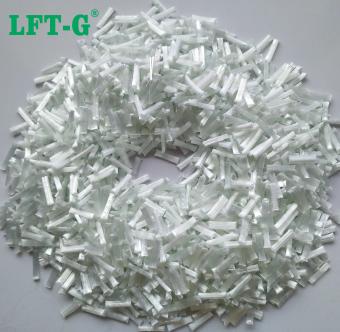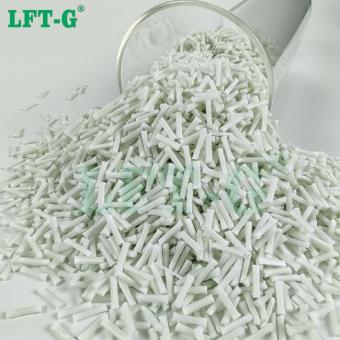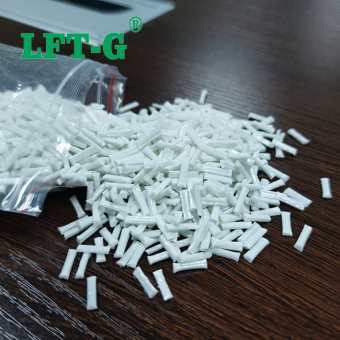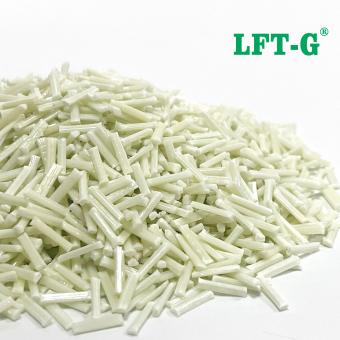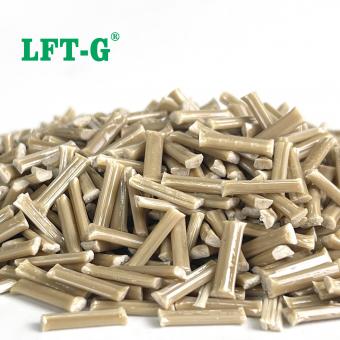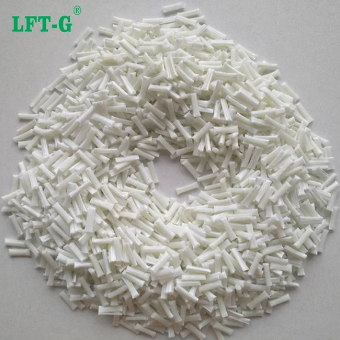-
Xiamen LFT Polyprolylene long carbon fiber reinforced granules for automotiverecycle and virgin long carbon fiber pp 94-V0 granules
- carbon fibre reinforced pp lcf pellet
- pp polypropylene homopolymer lcf
- long carbon fiber reinforced pp polymers
- long carbon fiber pp copolymer granules
- custom polypropylene pp lcf injection molding
- LFT PP polypropylene homopolymer
Tags :
-
LFT-G Polyphenylene Sulfide Composites Long Carbon Fiber Reinforced resinPPS Information Polyphenylene sulfide (PPS) is not enhanced before modification, its disadvantages are brittle, poor toughness, low impact strength, after filling glass fiber, carbon fiber and other enhancements modified to overcome the above shortcomings, to obtain very good overall performance. PPS filling Long carbon fiber In the modified engineering plastics industry, long fiber reinforced composites are composites made from long carbon fibers, long glass fibers and polymer matrix through a series of special modification methods. The most important feature of long fiber composites is that they have superior performance that the original materials do not have. If we classify them according to the length of the reinforcing materials added, they can be divided into: long fiber, short fiber and continuous fiber composites. Long carbon fiber composites are one kind of long fiber reinforced composites, which are a new fiber material with high strength and high modulus. It is a new material with excellent mechanical properties and many special functions. Corrosion resistance: LCF carbon fiber composite materials have good corrosion resistance and can adapt to the harsh working environment. UV resistance: the ability to resist UV is strong, and the products are less damaged by UV. Abrasion and impact resistance: the advantage of comparing with general materials is more obvious. Low density: lower density than many metal materials, can achieve the purpose of light weight. Other properties: such as reducing warpage, improving rigidity, impact modification, increasing toughness, electrical conductivity, etc. LCF carbon fiber composites have higher strength, higher rigidity, lower weight, and excellent electrical conductivity compared with glass fiber. PPS TDS for reference PPS Application Other products you can also contact us for more technical advice. Q&A 1. Are carbon fiber composite products very expensive? The price of carbon fiber composite products is closely related to the price of raw materials, the level of technology and the number of products. The higher the performance of the raw material, the more expensive it is, such as the carbon fiber PEEK thermoplastic material used in orthopedics. Of course, the more complex the manufacturing process, the greater the working time and workload, and the increased production costs. However, the larger the order quantity, the lower the cost per product. In the long run, the superior performance of carbon fiber will extend the life of the product, reduce the number of maintenance, and is also very beneficial to reduce the cost of use. 2. Are carbon fiber composite products toxic? Carbon fiber composites are made of carbon fiber filaments mixed with ceramics, resins, metals and other substrates, and are generally not toxic. For example, the above-mentioned PEEK material is made of food-grade resin, which is very compatible with the human body and is not only harmless to humans, but also becomes a more ideal material for orthopedic surgery because of its high strength and elastic modulus close to the bone cortex. Carbon fiber medical bed plate, will be in daily contact with many patients body, will not have adverse effects on the human body, on the contrary, for the accuracy of medical diagnosis and a great help. 3. What is the difference between thermosetting carbon fiber composites and thermoplastic carbon fiber composites? Thermoset carbon fiber composites favor the role of curing agent in curing and molding. While thermoplastic carbon fiber composite products mainly rely on cooling down to achieve the shaping. Thermoplastic carbon fiber composites are not as popular as thermoset carbon fiber composites, mainly because they are expensive and are generally used in high-end industries. Thermoset carbon fiber composites are difficult to recycle due to the limitation of the resin matrix itself, and are generally not considered; thermoplastic carbon fiber composites can be recycled, and can be made twice as long as they are heated to a certain temperature. About us We will offer you: 1. LFT & LFRT material technical parameters and leading edge design 2. Mold front design and recommendations 3. Provide technical support such as injection molding and extrusion molding
- PPS polyphenylent High rigidity and strength
- Low warpage electronic appliance light weight
- pps lcf40 granules raw material Polymers
- PPS long carbon fiber extrusion molding and injection molding
- pps LCf40 plastic injection part instead motal and steel
- carbon fibre reinforced pps lcf pellet
Tags :
-
LFT-G Polyphenylene Sulfide composite long carbon fiber thermoplastic resin high rigidity and strengthPPS Information Polyphenylene sulfide (PPS) is not enhanced before modification, its disadvantages are brittle, poor toughness, low impact strength, after filling glass fiber, carbon fiber and other enhancements modified to overcome the above shortcomings, to obtain very good overall performance. PPS filling Long carbon fiber In the modified engineering plastics industry, long fiber reinforced composites are composites made from long carbon fibers, long glass fibers and polymer matrix through a series of special modification methods. The most important feature of long fiber composites is that they have superior performance that the original materials do not have. If we classify them according to the length of the reinforcing materials added, they can be divided into: long fiber, short fiber and continuous fiber composites. Long carbon fiber composites are one kind of long fiber reinforced composites, which are a new fiber material with high strength and high modulus. It is a new material with excellent mechanical properties and many special functions. Corrosion resistance: LCF carbon fiber composite materials have good corrosion resistance and can adapt to the harsh working environment. UV resistance: the ability to resist UV is strong, and the products are less damaged by UV. Abrasion and impact resistance: the advantage of comparing with general materials is more obvious. Low density: lower density than many metal materials, can achieve the purpose of light weight. Other properties: such as reducing warpage, improving rigidity, impact modification, increasing toughness, electrical conductivity, etc. LCF carbon fiber composites have higher strength, higher rigidity, lower weight, and excellent electrical conductivity compared with glass fiber. PPS TDS for reference PPS Application Other products you can also contact us for more technical advice. Q&A 1. Are carbon fiber composite products very expensive? The price of carbon fiber composite products is closely related to the price of raw materials, the level of technology and the number of products. The higher the performance of the raw material, the more expensive it is, such as the carbon fiber PEEK thermoplastic material used in orthopedics. Of course, the more complex the manufacturing process, the greater the working time and workload, and the increased production costs. However, the larger the order quantity, the lower the cost per product. In the long run, the superior performance of carbon fiber will extend the life of the product, reduce the number of maintenance, and is also very beneficial to reduce the cost of use. 2. Are carbon fiber composite products toxic? Carbon fiber composites are made of carbon fiber filaments mixed with ceramics, resins, metals and other substrates, and are generally not toxic. For example, the above-mentioned PEEK material is made of food-grade resin, which is very compatible with the human body and is not only harmless to humans, but also becomes a more ideal material for orthopedic surgery because of its high strength and elastic modulus close to the bone cortex. Carbon fiber medical bed plate, will be in daily contact with many patients body, will not have adverse effects on the human body, on the contrary, for the accuracy of medical diagnosis and a great help. 3. What is the difference between thermosetting carbon fiber composites and thermoplastic carbon fiber composites? Thermoset carbon fiber composites favor the role of curing agent in curing and molding. While thermoplastic carbon fiber composite products mainly rely on cooling down to achieve the shaping. Thermoplastic carbon fiber composites are not as popular as thermoset carbon fiber composites, mainly because they are expensive and are generally used in high-end industries. Thermoset carbon fiber composites are difficult to recycle due to the limitation of the resin matrix itself, and are generally not considered; thermoplastic carbon fiber composites can be recycled, and can be made twice as long as they are heated to a certain temperature. About us We will offer you: 1. LFT & LFRT material technical parameters and leading edge design 2. Mold front design and recommendations 3. Provide technical support such as injection molding and extrusion molding
- PPS polyphenylent
- Low warpage electronic appliance
- pps lcf40 granules raw material
- PPS long carbon fiber extrusion
- pps LCf40 plastic injection part
Tags :
-
Xiamen LFT-G High Density Polyethylene Plastic filled long glass fiber reinforced compounds natural colorHDPE-LGF High density polyethylene (HDPE)/ glass fiber (LGF) composites were prepared by twin-screw extrusion mechanism, and the mechanical properties and non-isothermal crystallization behavior of HDPE/LGF composites were studied. The results show that the impact strength of the composite can be improved by MAH-g-POE, and the interface bond between the glass fiber and HDPE is good. The Avrami index (n) of the composite does not change with the cooling rate. Datasheet Application Package Xiamen LFT composite plastic Co.,Ltd Come and find us! We will offer you: 1. LFT & LFRT material technical parameters and leading edge design. 2. Mold front design and recommendations. 3. Provide technical support such as injection molding and extrusion molding.
- HDPE filling lgf20
- lgf hdpe composite materials
- reinforced hdpe plastic resin
- long glass fiber hdpe
- Thermoplastic hdpe lgf
- hdpe resin compounds
Tags :
-
Xiamen LFT-G Polybutylene terephthalate Long Glass Fiber Reinforced CompoundsThey are frequently used to replace metal for applications in which light weighting, improved impact strength, elastic modulus, and material strength are required.
- PBT modified plastic gf long glass fiber
- PBT thermoplastic engineering polymer
- GFRP PBT high toughness and rigidity sample available
- LFT PBT glass fiber reinforcement polymer good price
- PBT higher performance light weight instead metal
- low warpage PA6 for car parts
Tags :
-
Xiamen LFT PPA Polyphthalamide filled Long Glass Fiber reinforced plastic resinPPA (Polyphthalamide) is polyphthalamide.PPA is a kind of thermoplastic functional nylon with both semi-crystalline structure and non-crystalline structure. It is prepared by polycondensation of phthalic acid and phthalenediamine. It has excellent thermal, electrical, physical and chemical resistance and other comprehensive properties.
- 2023 New product made in China good price
- PPA resin long glass fiber GFRP high performance
- Thermoplatics material
- Sample available instead metal and steel
- Supplier price best thermoplastic resin
- general grade low warpage
Tags :
-
Xiamen LFT Polyamide 66 Reinforced resin Long Glass fiberReinforced Polyamide (nylon) resin PA66 Long Glass fiber is a mechanical component shield for high rigidity and dimensional stability, and is widely used in mechanical and electrical parts used in the electrical and electronic industry.
- Glass fibre reinforced polyamide thermoplastic resin
- Long Fiber reinforced Thermoplastics
- Thermoplastic Polymer low warpage
- Nylon Long glass fiber high quality made in China
- Application electrical parts PA66 Polyamide
Tags :
-
Xiamen LFT Polyamide 12 Filled Long Glass Fiber Compounds China manufacturerProduct Name: Polyamide12 long glass fiber composite,Nylon 12 composite Certificated: SGS, 16949 system certificated,MSDS,and so on.
- LFT PA12 LGF long glass fiber virgin grade
- Nylon Fill Long Glass Fiber polyamide 12 high strength
- Nylon 12 Plastic Price high rigidity
- Nylon Composite thermoplastic resin
- Nylon 12 LGF20 instead metal and steel
- Polyamide12 with fiber glass low warpage
Tags :
-
Xiamen High toughness Thermoplastic Urethane filled Long Glass Fibertpu injection molding and extrusion grade polyurethane recycle material
- tpu long glass fiber thermoplasitc composite
- long glass fiber reinforced plastic
- tpu polyurethane plastic long glass fiber
- long fiber tpu thermoplastic modified plastic
- tpu and polyurethane lgf instead metal
- long fiber thermoplastic made in China manufacturer
Tags :
-
Xiamen LFT Polylactic acid compounds filled long glass fiber thermoplastic resinPLA PLA (polylactic acid) is also known as polylactic acid, the production process of polylactic acid is pollution-free, and the product can be biodegradable to achieve recycling in nature, so it is an ideal green polymer material, and one of the representatives of biodegradable plastics. The structure of PLA has important influence on its heat resistance, toughness, mechanical strength, degradability and biocompatibility. The influence on heat resistance is mainly discussed below. There is only one submethylene on the main chain of PLA molecule, the molecular chain has a spiral structure, and its activity is poor. As a result, the PLA after injection molding almost does not crystallize due to slow crystallization speed, so the heat resistance of the product is poor. During hot processing, the ester bond is partially broken to produce terminal carboxyl group, which plays an autocatalytic degradation effect on the thermal degradation of PLA. LGF reinforced PLA The rigidity of the fiber makes it play the role of skeleton support in the polymer matrix. When the polymer is heated, the movement of the chain segment is limited, thus improving the heat resistance of the material. At present, the fibers that can be used for enhancement modification of PLA include natural plant fiber (sisal, flax, linen, bamboo, coconut, wood fiber, etc.), natural animal fiber (silk, etc.), mineral fiber (basalt fiber, etc.), and chemical fiber (carbon fiber, glass fiber, etc.). Among these fibers, carbon fiber and glass fiber are widely used for their high strength and high modulus. Natural plant fiber has been widely studied because of its wide source, degradability and improved thermal and mechanical properties of composites. Modified natural fiber and modified inorganic fiber (glass fiber or carbon fiber) were mixed into the PLA matrix to prepare two kinds of fiber reinforced PLA composites. The test results show that the Vica softening temperature of the composites exceeds 140℃. Compared with Short fiber(SGF) Compared with the short fiber, it has more excellent performance in mechanical properties. It is more suitable for large products and structural parts. It has 1-3 times higher (toughness) than short fiber, and the tensile strength (strength and rigidity) is increased by 0.5-1 times. Injection molding Lab Warehouse Certification Xiamen LFT composite plastic Co., Ltd Xiamen LFT composite plastic Co., Ltd. is a brand-name company that focuses on LFT&LFRT. Long Glass Fiber Series (LGF) & Long Carbon Fiber Series (LCF). The company's thermoplastic LFT can be used for LFT-G injection molding and extrusion, and can also be used for LFT-D molding. It can be produced according to customer requirements: 5~25mm in length. The company's long-fiber continuous infiltration reinforced thermoplastics have passed ISO9001&16949 system certification, and the products have obtained lots of national trademarks and patents.
- PLA composite plastic instead metal and steel
- polyactic acid materials High quality and strength
- modified pla compounds
- pla long glass fiber lgf made in China
- long glass fiber filling pla long fiber glass
- lft-g pla lgf thermoplastic resin virgin
Tags :
-
Xiamen LFT high temperature resistance Polyphenylene sulfide PPS filled long glass fiber polymerPolyphenylene sulfide PPS plastic (polyphenylene sulfide) is a special engineering plastic with excellent comprehensive performance, high strength, the sound of metal, and the material is as hard as metal. It also has the characteristics of high temperature resistance, cold resistance, acid and alkali resistance, wear resistance, flame retardant V0, low warping and excellent electrical properties. Compared with metal, PPS material products are light in weight, which is particularly important for mechanical equipment requiring self-weight reduction, such as vehicles, ships and aircraft. PPS material strength is high, compared with the weight of metal, PPS strength is much higher than the general metal, is the highest strength of existing structural materials. PPS material has good chemical stability, and has good corrosion resistance to general acids, alkalis and other chemicals. The electrical properties of PPS materials are very outstanding, in the high temperature, high humidity, high frequency environment, high volume resistivity and insulation resistance remain unchanged, is an excellent insulation material. PPS material has good wear resistance and can be used to manufacture a variety of self-lubricating bearings, gears and seals. PPS material molding processing is convenient, products can often be formed at one time, and metal products always have to go through several, more than a dozen, or even dozens of processes to complete the processing. Long glass fiber compounds "Center Fill" is LFT compounds that are obtained through our technology by charging glass fiber rovings composed of thousands of filaments into an impregnation process and impregnating the glass fibers uniformly with molten thermoplastic resin and then cutting the resultant product into pellets. Significantly improved impact resistance Increased stiffness and strength Good heat resistance Improved creep and wear characteristics Reduced the degree of warpage and deformation Reinforced properties of recycled crystalline and non-crystalline resins Details Name Fiber content Color Length MOQ TDS FOB Price Delivery polyphenylene sulfide filled long glass fiber polymer 20%-60% Natural color/Customized 6-25mm 25KG/Bag Contact us for TDS USD8.8-11.1/KG By ship or air Company profile Xiamen LFT Composite Plastic Co.,LTD was established in 2009, is a brand-name global suppliers of long fiber reinforced thermoplastic materials integrating product research & development(R&D), production and sale marketing. Our LFT products have passed the ISO9001&16949 system certification and have obtained lots of national trademarks and patents, covering the fields of automotive, military parts and firearms, aerospace, new energy, medical equipment, power wind energy, sports equipment, etc. Other materials you may interested PA66-NA-LGF PPA-NA-LCF PA12-NA-LGF
- Exceptional mechanical strength Polyphenylene sulfide plastic
- LFT PPS long glass fiber reinforced thermoplastic resin pellets
- PPS plastic granules high strength made in China
- PPS can be customized long cut fiber filament
- hot sell light weight plastic instead metal and steel
- engineering used plastic PPS good appearance gfrp
Tags :
-
Xiamen LFT reinforcement Polypropylene long glass fiber modifiedLong glass fiber reinforcement thermoplastic polypropylene resin
- Long fiber reinforced thermoplastics composite PP
- metal replacement PP polymer glass fiber reinforced
- High fatigue and creep endurance
- China manufacturer Polypropylene good price
- long glass fiber modified PP for car parts gfrp PP GF30
- higher performance than short/chopped glass fiber filled compounds.
Tags :

 e-mail
e-mail English
English français
français Deutsch
Deutsch русский
русский italiano
italiano español
español português
português العربية
العربية 日本語
日本語 한국의
한국의 中文
中文





